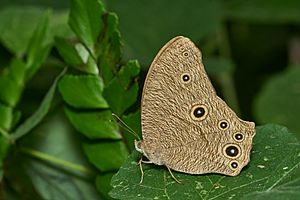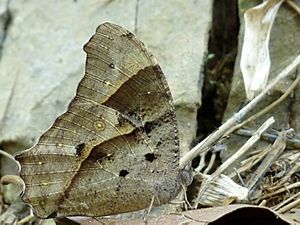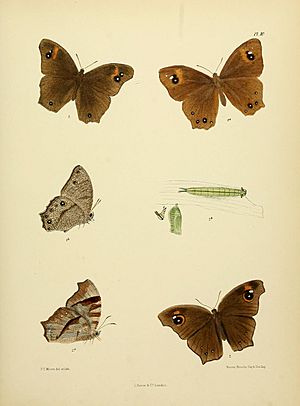Common evening brown facts for kids
Quick facts for kids Common evening brown |
|
|---|---|
 |
|
| Wet-season form | |
 |
|
| Dry-season form | |
| Scientific classification | |
| Kingdom: | |
| Phylum: | |
| Class: | |
| Order: | |
| Family: | |
| Genus: |
Melanitis
|
| Species: |
M. leda
|
| Binomial name | |
| Melanitis leda (Linnaeus, 1758)
|
|
| Synonyms | |
|
|
The common evening brown (scientific name: Melanitis leda) is a butterfly that you can often see flying around when the sun starts to set. These butterflies have a very quick and unpredictable way of flying. You can find them in many places, including Africa, South Asia, Southeast Asia, and even parts of Australia.
Contents
How to Spot the Common Evening Brown?
This butterfly looks a bit different depending on the season. This is called seasonal polyphenism. It helps them blend in with their surroundings.
Wet-Season Form
When it's the wet season, the butterfly's forewing (the front wing) has a somewhat pointed tip. The edge of the wing might be slightly angled. The top side of the wings is brown.
On the forewing, you'll see two big black spots near the tip. Each black spot has a smaller white spot inside it. These white spots are bordered by a reddish-brown, broken line. The edge of the wing near the body is a bit lighter.
The hindwing (the back wing) has a dark spot with a white center and a reddish-yellow ring. This spot is near the bottom edge. Sometimes, other spots from the underside of the wing can be seen through the top.
The underside of the wings is lighter brown. It has many thin, dark brown lines going across it. There's also a curved dark brown band on the forewing. On both wings, you'll find a series of eye-like spots, called ocelli. The forewing usually has four, and the hindwing has six.
Dry-Season Form
In the dry season, the forewing tip is more rounded and might be slightly curved like a sickle. The edge of the wing behind this curve can be straight or wavy. The main color of the top side is still brown, like in the wet season.
However, the markings are bigger, especially the reddish-brown lines around the black spots on the forewing. These lines spread out more. On the hindwing, the large eye-spot seen in the wet season is usually gone. Instead, you might see three or four tiny white spots near the bottom edge.
The underside of the wings can vary a lot in color during the dry season. The antennae, head, body, and abdomen of both seasonal forms are brown or grayish-brown. The antennae have white rings and are yellowish at the tip.
What Do Common Evening Browns Do?
These butterflies are quite interesting! They are known to be very territorial, especially around dusk. If another butterfly or even a small pebble comes too close, they might chase it away!
What Do They Eat?
The baby butterflies, called caterpillars, eat many different kinds of grasses. This includes common plants like rice (Oryza sativa), bamboos, and various types of millets. Some of the grasses they munch on are Andropogon, Rotboellia cochinchinensis, Brachiaria mutica, Cynodon, Imperata, Oplismenus compositus, Panicum, and Eleusine indica.
Adult butterflies mostly drink nectar from flowers. Sometimes, though it's rare, they might also visit rotting fruits to feed.
Image gallery
Images for kids
See also
 In Spanish: Melanitis leda para niños
In Spanish: Melanitis leda para niños







